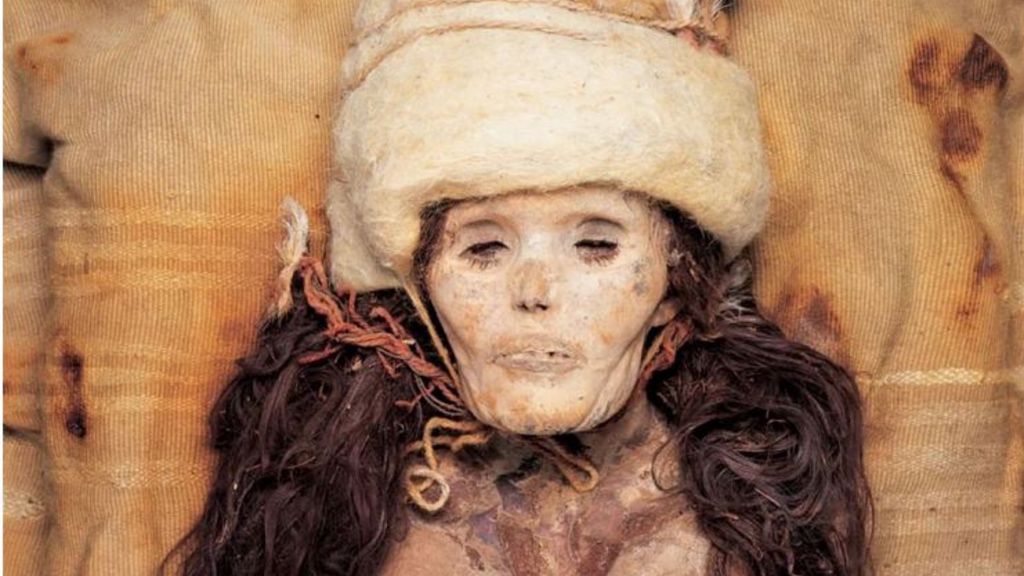The Tarim Basin mummies are remains from the Bronze Age dating back to between 2100 and 1700 BC. These mummies were gradually discovered from the nineteenth century until the beginning of the twenty-first century, and they did not cease to amaze with their Caucasian features: red or light hair, round eyes and straight noses. . Their woolen clothes as well as food scraps of wheat, barley and cheese made specialists believe they were nomadic pastoralists from West or Central Asia.
Chinese, American, Korean and German researchers collected the DNA of thirteen mummies and compared their genome sequences to determine their ancestors. The study’s press release says that this is the first genomic-level study of the prehistoric population of this region.
Local people surrounded by nomads
Genomic analysis revealed a surprise! Contrary to all expectations, the researchers found that the mummies were of local origin and direct descendants of a people called the “Ancient North Eurasia” (ANE). They are a very common people during the Ice Age, but suddenly declined at the end of the Ice Age.
Archaeological sites have been excavated in the area now known as “Xinjiang” (or Xinjiang Uyghur Autonomous Region) in western China. Today, this region was isolated, 4000 years ago, a crossroads located on the Silk Roads and a junction between East and West, and therefore a very cosmopolitan area. It is therefore surprising that these individuals from the Tarim Basin were not nomads passing through this crossroads, but rather local residents.
>>> To read also: In our genes that came from Neanderthals?
The missing piece of the puzzle: the ancient inhabitants of northern Eurasia
Archaeological geneticists have long been searching for prehistoric traces of Eurasians in the ancient north. ” We found them in the least expected place Happy Chun Won Jeong, one of the study’s authors and a professor at Seoul National University in Korea.
Today, the ancient North Eurasia line is only partially found in the genomes of the indigenous peoples of Siberia and America. These populations have a maximum of 40% of this ancient line of ancestry.
>>> To read also: We are all Cro-Magnon
A people genetically isolated but culturally cosmopolitan
Another surprising fact: people will be “genetically isolated”. That is, although they were exposed to a variety of visitors from all over the world, they did not “mix” with other tribes.
However, archaeologists’ analysis indicates that they were culturally open to these passages: proteomic analysis of dental calculus showed that they practiced diversified milk production. Food techniques and recipes based on dairy products from cattle, sheep, or goats allow archaeologists to speculate on people who are culturally knowledgeable and open to the cultures around them. ” They designed their cuisine around wheat and dairy products from West Asia, millet from East Asia and medicinal plants such as ephedra from Central Asia. Kristina Wariner, one of the study’s authors and a professor at Harvard University explains. Therefore, the mummies, paradoxically, are members of a “genetically isolated, but culturally cosmopolitan” people.
Buried in boats in the middle of the desert
The mummies have exceptional preservation that allows the details of their features and even their hair to be appreciated. Buried in boat-shaped coffins, it was the harsh desert conditions that led to the natural mummification of these individuals.
While today there are no rivers near the site, the presence of the remains of fishing nets can be evidence of dry rivers. Archaeologists also believe that the barge-shaped sarcophagi signify the great cultural importance of water among these people. The study authors hope to continue the genetic reconstruction of human remains in the region in order to better understand the historical migrations into the steppes of Eurasia.
>>> Read also: Archeology: The mummified priest was … a pregnant woman!

“Subtly charming problem solver. Extreme tv enthusiast. Web scholar. Evil beer expert. Music nerd. Food junkie.”

